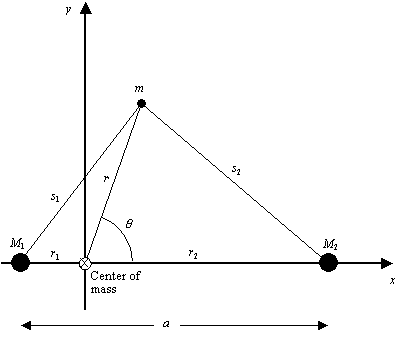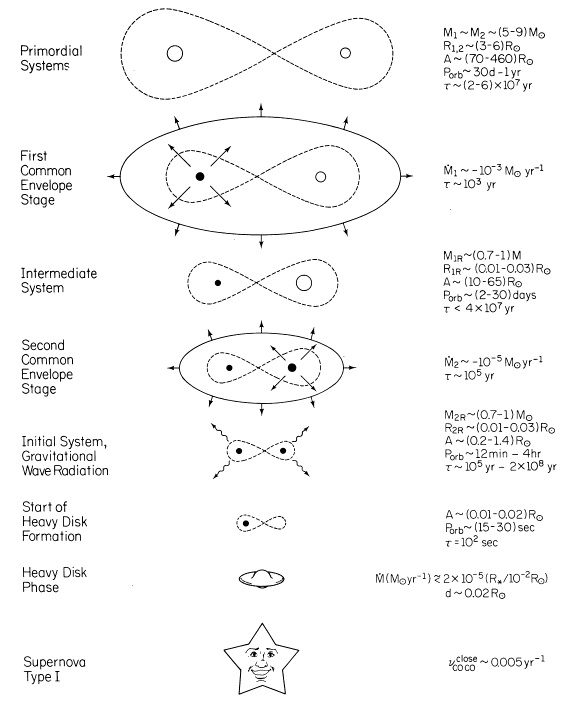At least half of
all stars in the sky are actually multiple star systems, with two or more
stars in orbit about their common center of mass. In this lecture
we will be concerned with systems that are close enough to significantly
interact over their lifetimes. Generally, such stars will exert a
tidal influence on each other, causing internal motions in the stars that
dissipates orbital and rotational energy until the two are tidally
locked, always facing each other. In this situation, the
system rotates rigidly in space, and although the stars may be distorted,
they are no longer losing energy due to the tidal interation.
To think about the environment
near these stars, consider a "test" mass, also rotating rigidly with the
system. Placing the center of mass of the system at the origin, the
small mass will feel the gravitation force from both stars, and also the
fictitious "centrifugal force" due to its own rotation with the system
Fc
= mw2r
Rather than work with forces,
we will consider things from the point of view of potential energy (recall
that F = -dU/dr),
so the fictitious centrifugal force on the mass is
|
 |
|
|
|
| Uc = - |
mw2rdr
= |
|
-1/2 mw2r
2. |
|
|
|
|
|
|
Thus, the total potential energy
in this rotating frame, shown in the figure below, is the gravitational
potential energy plus the centrifugal potential energy, or
U = - GM1m/s1-
GM2m/s2-
1/2
mw2r
2.

Corotating coordinates for
a binary star system
For convenience, we can write
this as an effective potential energy per unit
mass, F,
[erg / g]
F = -
G(M1/s1-
M2/s2)-
1/2w2r
2.
Note that the distances s1
and s2
can be written in terms of r1
and r2
through the law of cosines, and the angular frequency of the orbit comes
from Kepler's third law for the orbital period
w2
= (2p/P)2
= G(M1 +M2)/a3.
= G(M1 +M2)/(r1+r2)3.
Finally, from the definition
of the center of mass, we have
M1r1
= M2r2
Combining all of these expressions
allows us to evaluate the effective gravitational potential at every point
in the orbital plane of the binary star system. Figures 17.2 and
17.3 show the results, from which we can see the shape of the equipotential
surfaces (Fig. 17.3) and understand the locations and importance
of the Lagrangian points, especially
the inner Lagrangian point, L1.
Further
discussion, with pictures.
There are two basic
types of supernovae, classified according to observational characteristics
of their spectra near maximum brightness. Those that show no strong
hydrogen lines are Type I, those that do show strong hydrogen lines are
Type II. One type is the result of core collapse in a giant star,
while the other involves a white dwarf in a close binary system.
(Can you identify which is which?)
A recent, famous Type II
supernova was Supernova
1987A for which we can look at detailed timing
of events. Type II supernovae are responsible for all of the
elements heavier than iron in the universe, through nucleosynthesis.
There are two models for
Type I supernovae, although our text prefers the first scenario:
-
A carbon-core white dwarf accretes
matter from a companion until it reaches around 1.3 solar masses.
-
At that mass, the core suddenly
reaches sufficient pressure to begin fusing C into heaver elements.
-
Just as in the Helium flash,
the degenerate C cannot expand as temperature goes up, so there is a complete
conflagration
of the core until the degeneracy is explosively broken and the star releases
such energy that it is completely destroyed.
The second scenario starts the
same as the first, but the mass eventually exceeds the Chandrasekhar Limit
of 1.4 solar masses.

